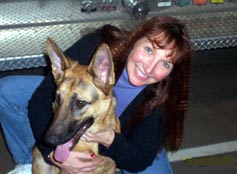

Monday - September 25, 2006
SLAC Today is
available online at:
http://today.slac.stanford.edu
In this issue:
WIS Seminar: A Journey through the Military
Dorfan Today: Space, the Last Frontier
Beam Alignment Experts Meet this Week
Safety First
Open Science Grid Receives $30M Award
 |
 |
|
Monday - September 25, 2006 |
WIS Seminar: A Journey through the Military
Lisa Cassells with her dog, Heidi. From the American Revolution up to the present-day conflict in Iraq, women have played an integral role in the U.S. military during times of war as well as during times of peace. Tomorrow, SLAC Construction Safety Engineer Lisa Cassells will discuss her own experiences in the military when she presents the WIS Seminar, "My Journey through the Military: Joys and Hardships." Before coming to SLAC, Cassells spent more than two decades in the military. In 1980, she joined the Army and participated in one of the military's first co-ed boot camps, an experience she calls an "amazing adventure." By 2001, one of her last years in the service, Cassells was an occupational safety and health worker for the Coast Guard, and found herself balancing the responsibilities of motherhood with the responsibilities of developing a safety plan at Ground Zero in the weeks after the terrorist attacks on the World Trade Center. In tomorrow's seminar, Cassells will recount these and other memorable moments from her lengthy and varied military career. All are invited to attend this presentation, which begins at noon in the Panofsky Auditorium. Learn more... |
||
|
|
||
 Space, the Last FrontierThere is no greater workplace tension than competition for the utilization of physical space. No matter what kind of organization one polls, the answer always comes back the same: space is the resource that people will fight for with the greatest passion. SLAC is no exception. However, we have a significant space crisis at the lab, and now is the time that we must confront it. In May 2005, we changed the SLAC organization so as to better serve the scientific mission and the management objectives of the laboratory as it looks to its future. With the Business Improvement and Transition Team (see related TIP article) and the Transition Working Group (TWG, see related SLAC Today article), we examined our business and financial management structures and evolved a new model for the laboratory that provides a smooth transition by 2009 from a DOE Office of High Energy Physics stewarded laboratory to a Basic Energy Sciences (BES) stewarded one. The TWG used the model to generate a detailed plan, including a bottoms-up rebuild of the full laboratory budgets for operating and capital funds, for the year 2009 and beyond. The TWG proposed plan, in all its aspects, received a very strong endorsement from the recently completed DOE BES Linac Operations Review. The final leg of planning this voyage of change is creating a plan that optimizes the allocation of space. Space utilization at SLAC currently reflects the historical missions of the laboratory and unless we take the challenging step to assess and redefine its use, our scientific objectives will be limited by the lack of mission-appropriate space. Here I am speaking to all forms of space: offices, common work and service areas, technical workspaces, specialized labs and workshops. We need also to consider the current and longer-term use and appropriate disposition of all the accelerator housings and other buildings that currently house major facilities and we need to reduce our dependency on temporary and/or sub-par space such as aging trailers. Read more... |
Beam Alignment Experts Meet at SLAC this Week
SLAC hosted the first IWAA conference in 1989, when the accelerator community began to see a need for engineers with special expertise. The last meeting was held at CERN in 2004. Talks and poster sessions begin Tuesday morning and run through Friday. More information about the workshop can be found online. Safety FirstsCan you think of a sophisticated organization, performing some of the most dangerous work imaginable, that experienced a series of identical near-misses and then declared them all to be "normal" because nothing exploded? Open Science Grid Receives $30M AwardScientists on the track to discovery got good news this month when a powerful computing tool received critical government funding. A five-year, $30 million award to the Open Science Grid Consortium, announced by the National Science Foundation and the U.S. Department of Energy's Office of Science, will operate and expand the Open Science Grid, a computing environment used by scientists to harness computing resources and scientific data from around the world. Read more... |
Events (see all | submit)
Access (see all)
Announcements
|
| | ||
|
|
||
 <%
Response.AddHeader "Last-modified", getArticleDate()
'Response.AddHeader "Last-modified","Mon, 01 Sep 1997 01:03:33 GMT"
'Monday, December 06, 2010
%>
<%
Response.AddHeader "Last-modified", getArticleDate()
'Response.AddHeader "Last-modified","Mon, 01 Sep 1997 01:03:33 GMT"
'Monday, December 06, 2010
%>View online at http://today.slac.stanford.edu//. |
||